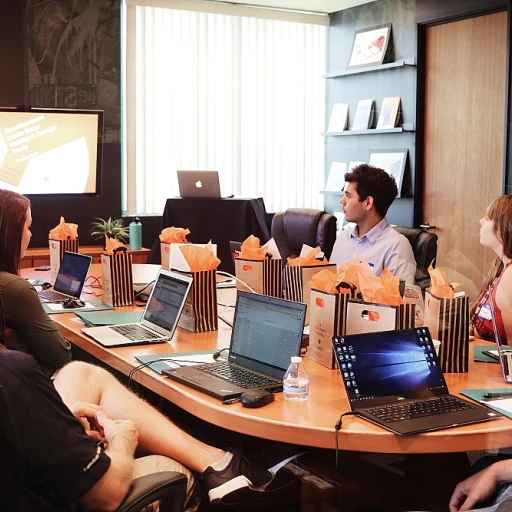
Understanding Simulated Environments
Embracing Virtual Landscapes
Understanding simulated environments is crucial for businesses aiming to foster innovation and enhance skills. These environments enable companies to create virtual settings, allowing them to experiment without the constraints of the physical world. Whether through advanced virtual reality, augmented reality, or even a combination of both, companies are leveraging these technologies to drive their innovation strategies. In today's fast-paced business landscape, where the integration of cutting-edge technologies is key, simulated environments are becoming indispensable. Whether in the automotive industry or corporate innovation labs, simulation is reshaping how businesses approach problem-solving and training tasks. By creating a digital mirror of the real world, companies are able to test innovative solutions in a controlled yet versatile setting. The rise of artificial intelligence and machine learning has further fueled the development of these environments. Autonomous driving, for example, relies heavily on real-time simulation to refine decision-making processes under various conditions. Moreover, industries such as retail use virtual scenarios to optimize the shopping experience by simulating consumer interactions in a controlled digital environment. For businesses considering adopting simulated environments, understanding the diverse applications and potential challenges is essential. By recognizing how these digital landscapes can be tailored to their unique needs, companies can strategically implement simulated environments as part of their broader innovation strategy. For more insights into how virtual opportunities might enhance skill sets, exploring virtual opportunities for skill enhancement can provide valuable perspectives.Pioneering Companies Using Simulated Environments
Pioneers in the World of Virtual Training
Simulated environments are gaining traction as a powerhouse tool for innovation, and several companies are at the forefront of this trend. Their groundbreaking use of virtual reality and data-driven simulations sets them apart as industry leaders, creating solutions that redefine corporate innovation strategies. Virtual reality has long been associated with the gaming industry, but innovative companies now harness it to facilitate training in diverse fields. The automotive industry, in particular, has embraced simulated environments for developing autonomous driving technologies. Companies from this sector utilize these realities to create simulations that mimic real-world conditions, providing engineers with a controlled yet authentic setting for testing. This approach ensures not only the safety of users but also speeds up the development process, significantly impacting the time-to-market for new products. In another example of cutting edge technology, the retail sector is exploring augmented reality to enhance the shopping experience for customers. By integrating digital solutions into their business models, companies aim to transform how consumers interact with products, bridging the gap between online and in-store shopping. These innovative solutions, driven by data and machine learning, enable real-time decision making, which is crucial for maintaining a competitive edge in the fast-paced digital marketplace. Fast company enthusiasts will also appreciate the efforts of technology titans in leveraging artificial intelligence in their innovation labs. Here, simulated environments play a pivotal role, providing a testbed for new ideas and fostering an environment ripe for creativity and development. These companies understand that to remain leaders, they need to continuously adapt and evolve, taking advantage of reality training techniques that equip their workforce with the skills needed for future challenges. Exploring virtual reality in education further showcases how innovative companies utilize these advancements for upskilling. This sector sees immense potential in simulation-based learning, offering individuals the opportunity to acquire skills in a controlled yet realistic manner. As these pioneering companies demonstrate, the integration of advanced technologies into training and development processes is revolutionizing how businesses can innovate and stay ahead in a competitive industry.Benefits of Simulated Environments for Upskilling
Enhancing Skills Through Virtual Simulations
In today's fast-paced business environment, companies are increasingly turning to simulated environments as a means to upskill their workforce. These virtual platforms offer a cutting-edge approach to training, allowing employees to engage in reality training that mirrors real-world scenarios. This method not only enhances learning but also accelerates the development of critical skills needed in various industries.
Real-Time Learning and Decision Making
One of the primary benefits of using simulated environments is the ability to provide real-time feedback. This immediate response helps employees understand the consequences of their decisions, fostering better decision-making skills. For instance, in the automotive industry, simulation and virtual reality technologies are used to train employees on autonomous driving systems, offering a safe space to experiment and learn without the risks associated with real-world testing.
Bridging the Gap with Innovative Technologies
Simulated environments leverage innovative technologies such as artificial intelligence and machine learning to create immersive training experiences. These technologies enable companies to design tailored training programs that address specific skill gaps. By integrating data analytics, businesses can track progress and adjust training modules to better suit the needs of their employees, ensuring a more efficient and effective upskilling process.
Creating an Innovation Lab Atmosphere
Companies that adopt simulated environments often create an innovation lab atmosphere, encouraging creativity and experimentation. This approach not only aids in skill development but also promotes a culture of continuous learning and innovation. Fast companies that have embraced this model report significant improvements in employee performance and engagement.
For businesses looking to enhance their workforce capabilities, adopting simulated environments can be a strategic move. By providing employees with the tools and technologies to learn in a virtual setting, companies can ensure they remain competitive in an ever-evolving digital landscape. For more insights on how to enhance your career with management systems courses, visit this resource.
Challenges in Implementing Simulated Environments
The Roadblocks in Implementing Virtual Settings
In the quest for innovation, companies often embrace technologies that promise to enhance efficiency. Simulated environments, heralded for their potential in upskilling and real-time training, aren't immune to challenges. Recognizing and addressing these obstacles is crucial for businesses seeking to fully harness the power of these virtual realms. A common hurdle is the upfront investment required. Building a digital simulation lab or implementing technologies like virtual reality and augmented reality demands significant resources. Companies must allocate budget not only for the technology itself but also for the necessary infrastructure and ongoing support. Beyond financial aspects, there is also the intricacy of integration. Incorporating simulated environments into existing business models can be daunting. It requires alignment with the company’s innovation strategy and a clear vision of how these tools will fit into the broader corporate innovation framework. Moreover, while virtual and augmented realities offer revolutionary training potential, ensuring these technologies are user-friendly is crucial. Without intuitive interfaces, participants in reality training may face steep learning curves, potentially hindering the effectiveness of these platforms. Data privacy and security also play a pivotal role. As simulations rely on vast amounts of real-time data, safeguarding this information becomes essential to prevent breaches that could threaten company integrity. Finally, there's the human factor: motivating and engaging participants. Facilitators must create realistic and motivating scenarios that align with the objectives of innovative companies. This demands expertise in both technology and human-centric design to foster genuine development opportunities. In conclusion, while the road to embracing simulated environments is paved with potential, companies must be prepared to navigate these multifaceted challenges. Addressing them head-on will ensure that the adoption of these cutting-edge technologies leads to truly rewarding innovation in the industry.Future Trends in Simulated Environments
Exploring Future Trajectories in Simulated Environment Development
In the ever-evolving landscape of technology and business, the role of simulated environments in shaping innovation is taking on new dimensions. As companies strive for cutting-edge solutions, they embrace advancements in virtual reality, artificial intelligence, and augmented reality. These technologies are set to redefine industry standards and drive corporate innovation to new heights. Virtual and augmented reality continue to gain ground, offering immersive experiences that revolutionize training and decision-making processes. By facilitating real-time simulation, these technologies allow businesses to experiment with innovative strategies in an impactful way. For instance, the automotive industry has implemented autonomous driving simulations to perfect new models, leading to enhanced safety and efficiency. Furthermore, fast companies are paving the way by integrating machine learning into their simulation environments. This enables a deeper analysis of data, which in turn informs strategic decision-making and refines business models. As these technologies progress, they are likely to become an integral component of innovation labs, empowering teams to test hypotheses and iterate over solutions in controlled settings. In the realm of digital innovation, agile approaches to simulated environments are paramount. While challenges exist—such as ensuring the right balance of resources and aligning new technologies with business goals—companies that successfully navigate these hurdles will gain a competitive edge. The ability to harness innovative solutions through simulations not only accelerates development processes but also enhances the overall shopping experience for end-users. In conclusion, companies must keep an eye on these future trends as simulated environments continue to evolve, offering unprecedented opportunities for growth and transformation in diverse industries. By strategically embracing these advancements, businesses can position themselves at the forefront of innovation.Practical Steps for Companies to Adopt Simulated Environments
Integrating Simulated Environments into the Business Model
For companies seeking to integrate simulated environments effectively, aligning these technologies with their business model is critical. Begin by identifying the specific areas where simulation can drive innovation and enhance decision making. This could be in product development, training, or customer experience.
Leveraging Technological Tools for Seamless Integration
The integration of technologies like virtual reality and machine learning into your company's workflow is essential. Companies in the automotive industry, for instance, use augmented reality and artificial intelligence to test autonomous driving technologies in safer, controlled settings. Embrace technologies that can be seamlessly incorporated into your business processes, thus offering innovative solutions that improve efficiency.
Creation of Dedicated Innovation Labs
Establishing innovation labs can offer a sandbox for testing and developing new ideas. These labs are crucial for fast companies aiming to stay at the cutting edge in their industry. Here, real-time data and simulations can be leveraged to solve complex problems, making the experimentation cost-effective and risk-free.
Fostering a Culture of Innovation and Training
A supportive corporate culture is paramount for the successful adoption of simulated environments. Encourage an innovation strategy that promotes ongoing training and development. Reality training through simulation creates a robust platform for employees to acquire new skills and apply them in real-world scenarios, fostering both personal and organizational growth.
Ensuring Data Security and Ethical Considerations
As you integrate simulated environments, address data security and ethical considerations diligently. Handling sensitive data responsibly ensures trust and compliance with industry standards, which is vital for sustaining long-term innovation.












